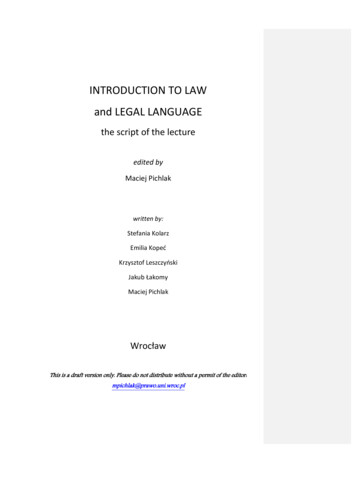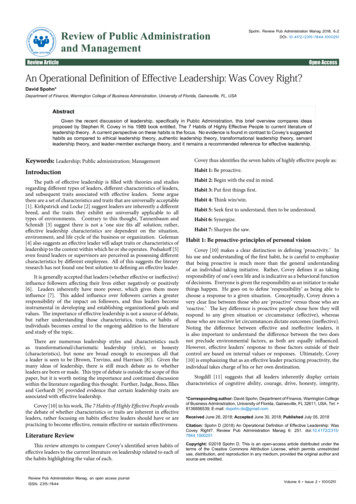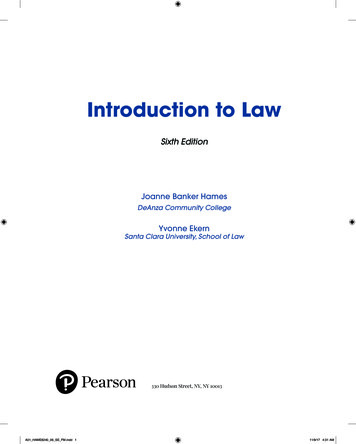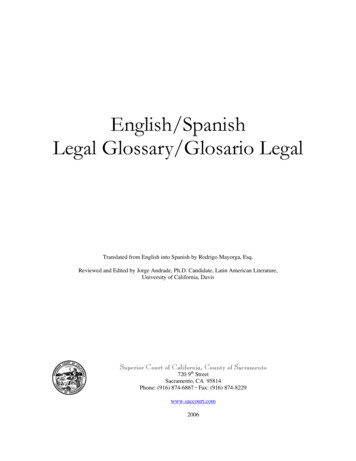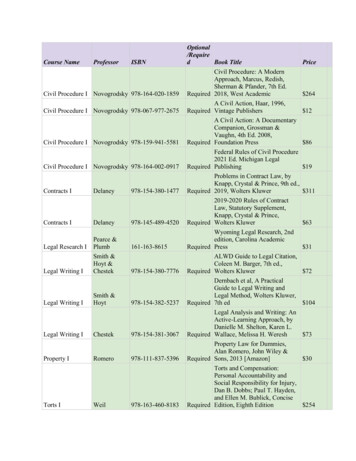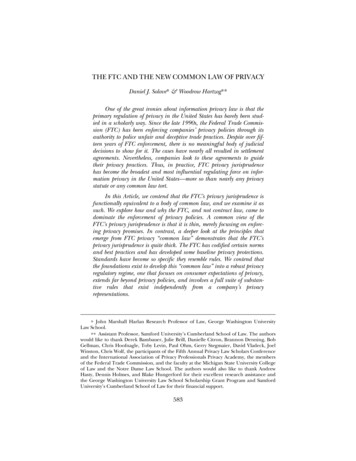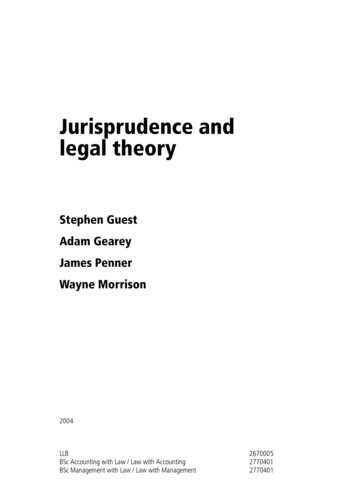
Transcription
Jurisprudence andlegal theoryStephen GuestAdam GeareyJames PennerWayne Morrison2004LLBBSc Accounting with Law / Law with AccountingBSc Management with Law / Law with Management267000527704012770401
This subject guide was prepared for the University of London ExternalProgramme by:Stephen Guest, BA, LLB, BLitt, PhD, Barrister, Inner Temple, Professor of Legal Philosophy,University College London.Dr Adam Gearey, Senior Lecturer in Law, Birkbeck College, University of London.James Penner, Reader in Law, London School of Economics.Dr Wayne Morrison, Director of the External Programme for Laws of the University of Londonand member of the Law School of Queen Mary College, University of London.Professor Guest took primary responsibility for Chapters 1, 2, 5, 6, 7, 10, 11and 14, Dr Geary for Chapters 13, 16 and 17, Dr Penner for Chapters 4, 8and 9, and Dr Morrison for Chapters 3, 12 and 15.This is one of a series of subject guides published by the University. We regretthat owing to pressure of work the authors are unable to enter into anycorrespondence relating to, or arising from, the guide.If you have any comments on this subject guide, favourable or unfavourable,please use the form at the back of this guide.Publications OfficeThe External ProgrammeUniversity of London34 Tavistock SquareLondon WC1H 9EZUnited Kingdomwww.londonexternal.ac.ukPublished by the University of London Press University of London 2004, September 2004 (E6130)Printed by Central Printing Service, University of London.Cover design by Omnis Partners, GlasgowAll rights reserved. No part of this work may be reproduced in any form, orby any means, without permission in writing from the publisher.2University of London External Programme
ContentsChapter 1Introduction5Chapter 2The nature of jurisprudence13Chapter 3Imperative or command theories of law23Chapter 4Classical and modern natural law theory61Chapter 5Introduction to the set book: Hart’sThe Concept of Law79Chapter 6A master rule for law: Hart’s rule of recognition97Chapter 7Hart’s defences against natural law andFuller’s criticism111Chapter 8Raz on practical reason and the authority of law119Chapter 9Practical reason and law133Chapter 10Kelsen’s theory of law155Chapter 11The integrity and interpretation of law173Chapter 12Social theory and law191Chapter 13Marx, Marxism and Marxist legal theory215Chapter 14Liberalism and law235Chapter 15Feminist legal theory247Chapter 16Critical legal studies267Chapter 17Critical race theory289University of London External Programme3
4University of London External Programme
Chapter 1 IntroductionContentsIntroduction 51.1How to study jurisprudence 61.2Reading 71.3Preparing for an examination in jurisprudence 9IntroductionThis subject guide has been written to show you how to lay a solidfoundation of knowledge and critical understanding inJurisprudence and Legal Theory. This will help prepare you,ultimately, for the examination. The guide is not intended as aprimary source, or a textbook, and it would be a mistake to treat itthis way.The best way to study is to commit yourself to a sustainedreading and writing programme from the beginning of thefirst term. It is typical for an internal student at the University ofLondon to spend two hours in seminars each week forJurisprudence throughout the academic year and, in addition, theequivalent of further full day’s work in the library, reading andtaking notes. In the two months before the examination, he or shewould normally begin to formulate coherent thoughts in the subjectby practising trial paragraphs, series of paragraphs, and finallyessays. The activities and sample examination questions in thisguide are designed to help you develop these skills.If you follow this pattern and, better, if you are able to let someoneelse read what you write and discuss it with you, you will placeyourself in the best possible position for achieving an excellentmark in the examination. Jurisprudence can be enjoyable. Thequestions it deals with are very important and they constantlyimpinge upon the consciousness of all lawyers. You really can go along way with this subject by a relaxed reading of a variety ofjurisprudential writing.Learning outcomes for this IntroductionBy the end of this Introduction, and the relevant reading, you should be able to:state the intended learning outcomes of the moduledecide which books to buy and obtain themlocate and distinguish the primary and secondary sourcesdevise an appropriate structure for an examination question inJurisprudence.University of London External Programme5
Jurisprudence and legal theoryEssential reading for this chapter11Freeman, M. (ed.) Lloyd’s Introduction to Jurisprudence. (London: Sweet &Maxwell, 2001) seventh edition [ISBN 0421690208].Read these before you go on toChapter 2.Dworkin, R. Law’s Empire. (Oxford: Hart Publishing, 1998).[ISBN 1841130419] Chapter 1.MacCormick, N. and W. Twining ‘Legal Theory and Common Law’ in B.Simpson (ed.) Legal Theory and Legal History: Essays on the Common Law.(London: Hambledon Press, 1987) [ISBN 0907628834] Chapter 13.Hart, H. Essays in Jurisprudence and Philosophy. (Oxford: Clarendon Press,1983) [ISBN 0198253877] Chapter 1: ‘Definition and theory injurisprudence’ (also in 70 Law Quarterly Review 37).Fuller, L. ‘The Speluncean Explorers’ in Freeman, pp. 51–63 (also in 62Harvard Law Review 616) (see above).1.1How to study jurisprudenceAn initial problem in studying jurisprudence is the orientation ofthe subject.Come to it with an open mind and do not bother if at first it is notobvious why you should be studying it or what use it will be to inyour future career. The answers to these questions will becomeclear to you during the year. If you study properly, you will gain abroad and flexible approach to legal questions of all sorts.Jurisprudence allows you to step back from the minutiae of whatyou’re doing in the core subjects and speculate on more general,but equally pressing, questions of law. In popular language, youwill learn how to think laterally.Teachers of jurisprudence well understand that for first-comers tothe subject, the initial orientation can be hard going. They are alsoused to the enthusiasm that frequently develops later, and whichremains for a very long time. We frequently meet former students,some now distinguished practising lawyers, who at alumnifunctions tell us that they would ‘like to have spent more timestudying jurisprudence’. Our experience, too, is that this seeminglyunpractical subject is not unpopular with practising lawyers. Don’tbe the unsuspecting interviewee who says ‘I hated jurisprudencebecause it meant less time on commercial law, taxation, etc.’because that can strike just the wrong note with a future employer.Flexibility and breadth in thinking and writing are both soughtafter criteria of employability.You should note early on that facts are much less important injurisprudence. It is the ideas that are important. True, the subjecthas facts, and case-law type subjects are not devoid of ideas.Nevertheless, there is a far greater proportion of abstract,theoretical material in jurisprudence, and the single most commonproblem is failure to appreciate this. Read Fuller’s ‘The Case of theSpeluncean Explorers’ for an enjoyable way to see how a relativelysimple set of facts lends itself to vastly different approaches, eachcharacterised by certain abstract ideas. That article, by the way, isused as the introductory reading in jurisprudence in law schools allover the world.6University of London External Programme
Chapter 1 Introduction1.2ReadingEssential reading2Freeman, M. (ed.) Lloyd’s Introduction to Jurisprudence. (London: Sweet &Maxwell, 2001) seventh edition [ISBN 0421690208].2Subsequently, we will refer to theessential reading texts simply by theauthor’s name: ‘Freeman’, ‘Hart’ etc.Penner, J. et al. (eds) Jurisprudence and Legal Theory: Commentary andMaterials. (London: Butterworths LexisNexis, 2002) [ISBN 0406946787].Hart, H. The Concept of Law. (Oxford: Oxford University Press, 1994) secondedition [ISBN 0198761228].THIS IS THE SET BOOK AND IT IS VITAL THAT YOU BUY IT.Recommended textsThe following are books that could be usefully bought, but if theyare readily available from a library, that is fine:Dworkin, R. Law’s Empire. (London: Fontana Paperbacks, 1986)[ISBN 0006860281].Hart, H. Essays in Jurisprudence and Philosophy. (Oxford: Oxford UniversityPress, 1983) [ISBN 0198253877].Morrison, W. Jurisprudence: From the Greeks to Post-modernism. (London:Cavendish, 1997) [ISBN 1859411347].Simmonds, N. Central Issues in Jurisprudence: Justice, Law and Rights.(London: Sweet & Maxwell, 2002) [ISBN 0421741201].Useful further readingOther works that you will find useful throughout the module are:Berlin, I. ‘Two concepts of liberty’ in Four Essays on Liberty. (Oxford: OxfordUniversity Press, 1979) [ISBN 0192810340].Cotterrell, R. The Politics of Jurisprudence. (London: Butterworths Law,2003) second edition [ISBN 0406930554] Chapter on Bentham and Austin.Devlin, P. The Enforcement of Morals. (Oxford: Oxford University Press,1965) [ISBN 0192850180].Dworkin, R. Law’s Empire. Chapters 1, 2 (particularly pp. 76–86), 3, 5(particularly pp. 164–75), 6, 7, 8 and 10.Dworkin, R. Taking Rights Seriously. (London: Duckworth, 1977)[ISBN 0715611747] Chapters 4 and 5.Fuller, L. ‘Positivism and fidelity to law – a reply to Professor Hart’ (1958)Harvard L.R. 690 (extracts in Freeman, pp. 370–373).Guest, S. Ronald Dworkin. (Edinburgh: Edinburgh University Press, 1997)second edition [ISBN 0748608052] Chapters 2, 3, 4, 7 and 8.Guest, S. (1988) Law Quarterly Review 155 (Review of Law’s Empire).Hart, H. Essays in Jurisprudence and Philosophy. Essay 1 (particularlypp. 21–35), Essay 2, Essay 3 and Essay 16.Hart, H. Law, Liberty and Morality. (Oxford: Oxford University Press, 1962)[ISBN 0192850172].Hohfeld, W. Extracts in Freeman, pp. 510–514.Rawls, J. A Theory of Justice. (Oxford: Oxford University Press, 1972)[ISBN 0198243685] pp. 22–27, and pp. 46–53.Raz, J. ‘The purity of the pure theory’ (1981) in Freeman, pp. 327–37.University of London External Programme7
Jurisprudence and legal theorySimmonds, N. Central Issues in Jurisprudence. Chapters 1, 3, 5; pp. 58–62(including suggested reading); and Chapters 8 and 9, particularly pp. 135–52,including reading.Waldron, J. Law. (London: Routledge, 1990) [ISBN 0415014271] Chapter 5.Williams, B. ‘The idea of equality’ in P. Laslett and W. Runciman (eds)Philosophy, Politics and Society. (Oxford: Blackwell, 1962)[ISBN 0631048804] p.125.1.2.1How to read works in jurisprudenceAppreciate that the subject-matter is difficult. You will have to learnto read difficult to understand works. This means that you shouldslow down and contemplate everything carefully. It is not likereading a light novel! And for that matter, as you know, reading thereports of judicial decisions can be difficult. Each chapter of the setbook, Hart’s The Concept of Law, requires several hours, sustainedeffort.Every so often, ask yourself what you’ve just read. Put your bookdown and write down, or speak aloud, what the writer has said.You will find that, if you can do it, you will remember having doneit!The great jurists were straightforward people who spoke naturallyand not in jargon. What they have in common is:sound moral perceptionthe intellectual ability to range from the very abstract to thevery practical.The primary sources, it should go without saying, are the best.You must read some of Austin, Kelsen, Dworkin, Fuller and so on.Only in that way will what these people say become real to you. Itis relatively easy for an examiner to spot whether you have or havegleaned your knowledge of jurisprudence from a primary source.They remain the most important and fruitful of the texts that youshould read. As far as secondary texts are concerned, Freeman andPenner have already been mentioned. An excellent overviewintellectually is Simmonds’ Central Issues in Jurisprudence.Many find Dworkin very difficult to read, mainly because he is amore abstract thinker than most. But he is worth the effort. Hismost accessible work is his article ‘The Model of Rules’ (itsometimes appears as ‘Is Law a System of Rules?’) nowincorporated as Chapter 2 of Taking Rights Seriously. Chapter 1 ofLaw’s Empire is also very readable. There is a secondary source forDworkin in Guest’s Ronald Dworkin (1997).1.2.2Learning outcomes for the module as awholeBesides getting to know the syllabus, which is printed in theRegulations, you should regard the following learning outcomes aswhat the subject will produce if conscientiously and seriouslyfollowed. The assessment in the final examination will be based onyour performance.By the time of the examination you should be able to:expound and criticise important ideas of selected jurists in theAnglo-American traditions8University of London External Programme
Chapter 1 Introductiondemonstrate an ability to think in a more abstract or generalfashion than is generally achieved in the study of specific areasof lawdemonstrate a willingness to question and think independentlyand to find out moredemonstrate systematic readingdemonstrate a thorough reading of Hart’s The Concept of Law,showing a sympathetic yet critical appreciation of the majorarguments of that book.These outcomes are related. Reinforcement of what the examinersare looking for will be found by studying past examination papersin which you will spot the familiar forms of questions and format.How well you read around the subject is crucial to how well you doin the examination. The examiners do not want to read parrotedpieces of information. Such answers will fail. Topic spotting will notdo either. The present syllabus is short enough for all topics to becovered and for all of them to be approached in an intelligent andsystematic way.1.3Preparing for an examination in jurisprudence1.3.1Content and orientation of youranswerSample or model answers can be a disastrous way of teachingjurisprudence since they suggest that there is only one right way ofanswering a question. In fact if each reader displayed realimagination and ingenuity – based on some knowledge, of course –all the answers would receive firsts, and no two answerswould be the same. But there are some pointers that can begiven in the following example. This question appeared in the 2004Home paper:‘Does utilitarianism provide solutions that we could adopt when we areconsidering what, morally, to do?’ContentHere is an example of the content that should be in the answer:A clear and reasonably detailed account has to be given ofutilitarianism. You should see the subject guide Chapters 3 and13 and you should return to what I am saying here again whenyou have mastered the reading in those two chapters. Thisaccount would have to be fair to utilitarianism as well as beingfair to its critics. If, for example, you were a utilitarian, it willhelp your case to make the version of utilitarianism you acceptas strong as possible and it will also help that you can handlethe strongest criticisms that can be made of it. If you are autilitarian, then probably the strongest form will be some formof rule utilitarianism, because that can most easily explain thestatus of moral and legal rights.OrientationWhat is also required is an orientation of your own.This means stating clearly whether you agree or not, givingreasons. Giving reasons is important because it is typical forUniversity of London External Programme9
Jurisprudence and legal theorycandidates to say in an examination that they either agree ordisagree with some proposition without saying why. In acourtroom, as a future lawyer, would you think it was acceptable,to your client, to the judge, simply to say ‘I disagree’ with theargument on the other side? Of course not! So, you might saysomething like the following in this part of your answer:Critics of utilitarianism emphasise3 the strength of ourmoral intuition that people have rights – the right, for example,not to be killed. They say that the existence of these rightsdefeats a utilitarian calculation that the greater good would beserved by killing, as, for example, in cases where to removefeeding tubes from irreversibly comatose patients wouldconserve hospital beds and save money, or where to kill adrunk tramp (secretly, painlessly and unbeknown to him)would contribute to cutting petty crime. This argument ispowerful because it focuses on the ultimate reason forpreferring utilitarianism, namely, that it is people who are therecipients of acts directed at the public good and so suggeststhat utilitarianism is fundamentally confused.3We have emphasised the crucial moves inthe argument in bold type.But there are two answers to this powerful objection. Thefirst is that, because the rationality of the utilitarian doctrinelies in the fact that it describes practically all of our intuitions,it can lead us to better conclusions than our intuitionscan in troublesome cases. The second is that we can say that‘there is a rule that’ we must not kill, under which irreversiblycomatose people and tramps have ‘rights to life’, andobservance of that rule in all cases in the long run leads to thegreater good.These two solutions point in different directions. In my view,the second is to be preferred because that is morereconcilable with our intuitions than the first. It is difficult tobe told, as Smart tells us, that on occasions we must not be‘morally squeamish’ about doing what utilitarianism requiresfor, after all, morality requires that we ‘care’, and must do so inevery case. But rule utilitarianism reminds us that people haverights – and so that intuition is satisfied and in terms of atheory which ultimately relies on our aiming for the morallygood consequences for society.1.3.2Structure of your answerThe following remarks concern the structure that should be in theanswer.An opening paragraph, or set of paragraphs, which should haveimpact. This sets out what you are going to do clearly andsuccinctly and gets straight into it.As in the above argument on utilitarianism, the centre sectionshould contain argument backing up your views. (You canshare views with others, giving reasons; but merely parrotingothers is out.) The point is that these ideas must be yours andyou must back them up.A summing up in which you draw your conclusion. Thisshould not be a repetition but a neat summary of your view.This summary shows that your answer forms an argument inwhich you have set out to do something and that you have10University of London External Programme
Chapter 1 Introductiondone it. You must tell the examiner that you are, or are not, autilitarian!Finally, the following is designed to get you to see what would bevery desirable in answering the question.A jurisprudence answer must show knowledge, independentthought and the ability to argue. In addition, it must show anability to cross-reference to other ideas and writers. This last isessentially the ability to think abstractly. Note the reference torule utilitarianism and to Smart in the above two paragraphsabout utilitarianism.Use examples. It is always helpful to show your awareness thatjurisprudential questions must be tested against real life. Notethe reference to the ‘irreversibly comatose patient’ and to the‘drunk tramp’ in the above.Reminder of learning outcomesBy this stage you should be able to:state the intended learning outcomes of the moduledecide which books to buy and obtain themlocate and distinguish the primary and secondary sourcesdevise an appropriate structure for an examination question inJurisprudence.Good luck!Stephen Guest, Adam Gearey, James Penner and Wayne Morrison.July 2004University of London External Programme11
Jurisprudence and legal theoryNotes12University of London External Programme
Chapter 2 The nature of jurisprudenceContentsIntroduction 132.1What is jurisprudence? 142.2Methodology, analysis, theory and the idea of definition 152.3Theory and evaluation 162.4The interpretive approach 18IntroductionThis chapter introduces you to the subject-matter of jurisprudence,and in particular to the different methods that jurists have used toproduce their theories of law. The broad distinction very commonlyused between two types of theory is that they are eitherdescriptive of the subject-matter of law, in all its forms, or thatthey are normative or prescriptive about what the subjectmatter of law ought to be. These two ideas – the descriptive andthe normative – are very common in jurisprudential thought. Inrecent years in Anglo-American jurisprudence, they have beenjoined, largely through the work of Ronald Dworkin, by a third typeof theory, an interpretive theory. All these ideas need to beexplained.Learning outcomesBy the end of this chapter and the relevant reading, you should be able to:distinguish, giving examples, between ‘descriptive’, ‘normative’ and‘interpretive’ theorisingindicate what some major problems of jurisprudence arediscuss critically the point of defining lawexplain your own view of the relationship between theory and practice.Essential readingDworkin, R. Law’s Empire. Chapters1 and 2.Freeman, M. (ed.) Introduction to Jurisprudence. Chapters 1 and 2.Hart, H. The Concept of Law. Preface and Chapters 1 and 2.Hart, H. Essays in Jurisprudence and Philosophy Essay 1, particularlypp. 21–35 (this essay is Hart’s famous inaugural lecture at the University ofOxford, which he delivered in 1952), and Essay 3.University of London External Programme13
Jurisprudence and legal theoryPenner, J. (ed.) Jurisprudence and Legal Theory. Chapter 1.Case: Madzimbamuto v Lardner-Burke (see [l966] RLR 756; SA l968 (2)284; and [l965] A.C. 645.2.1What is jurisprudence?Jurisprudence consists of the study of the nature of law and itsrelated ideas.Many of the difficult problems are purely philosophical. Thefollowing are such problems, and you will be expected to developyour own views in relation to them. What is definition? What is arule? What is law? What is morality? What is justice? What is acritical standpoint?But there are also interesting questions of political moralitywhich impinge on your life. Examples are: Should the law enforceconventional morality? What is the relationship between freedomand equality? How should difficult legal cases be decided? Canequality take into account differences between sexes? Shouldjudges be concerned with economic questions? What follows from aperson’s ‘having a right’ to something? What is the justification, ifany, for punishing people? Should ‘hate speech’ be a criminaloffence? Jurisprudence will help you formulate your convictions onthese vital questions.There are, finally, interesting questions of sociology andhistory. The following are such questions. What generally shapedthe law in Western societies? What were the main claims of thefeminists? What major trends influenced law schools in the UnitedStates in the twentieth century? What are the effects of law? Whatevents can be shaped by the adoption of laws? Is law of any sortnaturally repressive – or liberating?Jurisprudence is full of outstanding thinkers. Austin and Bentham –both of whom, in their own ways could be claimed to be thefounders of legal education at the University of London, thoughtlaw was about power. Hart and Kelsen thought it was imbued withauthority – although not moral authority as did Fuller of theHarvard Law School and as does Dworkin. Austin thought judgeswere deputy legislators. Dworkin thinks that judges only create lawthat is largely coherent with existing legal practice. Marxists thinkthat law only serves the interests of the powerful and the rich. The‘critical legal scholars’ think law schools provide a veneer ofrespectability over chaos and conflict. Some jurists believe thatcourts enforce moral rights; others, such as Bentham, think that thisidea is ‘nonsense upon stilts’.Or take Kelsen, the distinguished constitutional lawyer,international lawyer and jurist. One only has to observe many ofthe great constitutional cases fought in the highest courts incountries of present or former Commonwealth jurisdiction over thepast 30 years to see the impact that Kelsen had. Indeed, the 1,000pages of the 1965 decision of the Rhodesian General Division courtof Madzimbamuto v Lardner-Burke (see [l966] RLR 756; SA l968(2) 284; and [l965] AC 645) portray a formidable line-up of juristswhose ideas were marshalled both for and against the Rhodesiangovernment’s case. The example of the Nazi legal system, too, with14University of London External Programme
Chapter 2 The nature of jurisprudenceits barbaric laws, has also raised real, live problems. Did Nazibureaucrats really have a legal defence of any sort at all when theydeclared that they were just obeying orders? This was an acuteproblem at the famous Nuremberg war crimes trials which tookplace after the Second World War had ended. It continues to be alive issue.2.2Methodology, analysis, theory and the idea ofdefinitionEssential readingDworkin, R. Law’s Empire. You should read the whole of this as soon aspossible; to start with it would be useful to follow up some of the referencesto ‘interpretation’ in the index.Finnis, J. Natural Law and Natural Rights. (Oxford: Oxford University Press,1980) [ISBN 0198761104] Chapter 1.Hart, H. Essays in Jurisprudence and Philosophy. Intro, pp. 1–6, especiallypp. 5–6; and Essay 1 The Concept of Law. (second edition) Chapter 9.Raz, J. Ethics in the Public Domain. (Oxford: Oxford University Press, 1994)[ISBN 0198258372] Chapter 8: ‘A problem about the nature of law’.It is vital early on to get a ‘feel’ for what the different jurists youstudy are trying to do. It is important to distinguish a ‘descriptive’theory – loosely, one that describes things ‘as they are’, as ageographer might describe a continent, or a riverbed – from a‘normative’ theory. This latter causes some difficulty at first,because of the unfamiliarity of the term. But it means a theorywhich says how people ought to or may behave (or must, orshould, etc. you’ll get the idea). You should therefore be able tosee why normativity and rule following are two closely relatedideas. Laws are normative because they tell people how they oughtto, or may, behave. And a moral theory like utilitarianism is anormative theory because it says that people ought to act in theinterest of the general happiness.There are two important things to note. Examination candidatesoften misunderstand them:A theory can be descriptive and normative at the same time.This would be the case where a theorist said ‘this is what law islike’ and ‘this is how we ought to regard law’. Some peoplehave argued that the best way to read Hart is like this.The subject matter of a descriptive theory can be normative. Adescriptive theory of law will often be like this, since thesubject matter is at first sight normative. For example, wemight describe part of the law of England by saying ‘The lawis (description) that people ought not (normativity) to obtainproperty by deception, according to s.15 of the Theft Act 1968.’Hart, Dworkin, Raz and Finnis are very sensitive to thesedifferences, but many other theorists are not.University of London External Programme15
Jurisprudence and legal theoryActivity 2.1Give five or six examples of descriptive and normative statements from science,art, literature, music, morals, law and politics. Contrast them, pointing out thesignificant differences.Start by indicating which of the following statements are descriptive and whichnormative: ‘Picasso’s painting Guernica is 20 feet by 10 feet and is mostly blackmarks on white’ ; ‘Guernica is one of the great works of art of the twentiethcentury’. Further example: ‘You have a lot to learn’; ‘You ought to get started’.Are any of your examples also theoretical statements? What is a theoreticalstatement?Feedback: see page 21.2.3Theory and evaluationSubtle awareness of the role of evaluation in theorising is displayedby Finnis in Chapter 1: ‘Evaluation and the description of law’ of hisNatural Law and Natural Rights. It is difficult to read but it is wellworth it. What is interesting is his affirmation of the theoreticalapproach devised by Weber (see Chapter 12 of this subject guide):‘ that the evaluations of the theorist himself are an indispensableand decisive component in the selection or formation of any conceptsfor use in description of such aspects of human affairs as law or legalorder.’Try to see what this means by considering the following comparisonbetween two evaluative theories of what baldness is. If we cansee differences here, it would seem that the case is clearlyestablished for seeing differences in something like law.The trichologist, whose job it is to sell hairpieces and baldnesscures, is only interested, qua baldness, in the inability to growhair. His skinhead son, not interested in earning a living, thinksbaldness is a style thing, one for which the ability to grow hair isnecessary as it shows youth, vitality and sexual power. Dad and sonmight ask each other to revise their central conceptions of baldness(‘it’s where the money is, son’; ‘style’s more important than money,Dad’). It seems right to say, along with Finnis, that these differencesin outlook cannot be resolved by reference to language.Activity 2.2Consider the trichologist and his skinhead son. This analogy seems powerful. Howpowerful is it really?Is there really a ‘common’ concept of baldness that both of them share?Does it make sense to say that they differ in their ‘conceptions’ of thisconcept?Would it matter if neither of them had never used the word ‘concept’ in theirlives before?What is a ‘concept’?Feedback: see page 21.16University of London External Programme
Chapter 2 The nature of jurisprudenceThe approach to theorising I’ve just outlined is much moreprevalent now, although there is a school of jurists who think thatproper philosophical analysis proceeds by way o
The Concept of Law 79 Chapter 6 A master rule for law: Hart’s rule of recognition 97 Chapter 7 Hart’s defences against natural law and Fuller’s criticism 111 Chapter 8 Raz on practical reason and the authority of law 119 Chapter 9 Practical reason and
